In the modern business world, traceability is no longer a luxury — it is a necessity.
Nowhere is this more true than for chemical companies where the pressure to demonstrate the origin, composition, and safe disposal of products is most vigorous. In Europe, this is driven by a mix of stringent regulations such as REACH (Registration, Evaluation, Authorisation and Restriction of Chemicals), growing customer demand for transparency, and increased scrutiny around environmental and human health impacts.
At the heart of a chemical product’s traceability is the concept of product lifecycle management. Known simply as PLM, product lifecycle management involves collating the data on production processes, raw material sources, handlers, designers, and sales information from a chemical’s inception to retirement.
Related articles: How AI Can Assist Even the Smallest Chemical Company or How Can Chemicals Trading be Made More Efficient?
This transparency is vital not just for legal compliance, but also for rapid responses to quality issues, recalls, or sustainability audits. Without managing traceability, chemical companies risk non-compliance, reputational damage, and financial penalties.
Moreover, as the EU moves towards a circular economy and climate-neutral goals, traceability supports sustainability claims and helps companies measure progress against green targets. In essence, it is becoming a core part of the chemical sector.
As is to be expected, there are numerous sets of laws and standards to be met with regards to traceability. As the British Chemical Industry Journal noted in a recent report, “Whether dealing with REACH, OSHA, EPA, CLP, or international standards like ISO 9001 or GMP, chemical manufacturers face some of the strictest requirements in global industry.” Concluding that, “A traceable production process is often a non-negotiable prerequisite for gaining market access or passing audits.”
But because most chemical products are manufactured as a composite of many chemicals and industrial feedstocks, establishing a clear path can be a daunting task.
Fortunately, the Chemical Industry Journal also gives advice on how best to achieve traceability by breaking the task down into more manageable portions. When doing so, areas to be considered include:
Clear Documentation and Communication: Make certain that traceability data, such as batch records, safety data sheets (SDS), and COAs (Certificates of Analysis), is readily available and regularly maintained. If quality problems arise or if recalls become necessary, open and honest communication with suppliers and consumers can help improve credibility and minimise miscommunication.
Labelling, Barcodes, and GHS Compliance: Physical identification of a chemical product is still necessary even with increasingly digitalised settings. For inventory, shipping, and safety compliance, labelling systems should be able to scan barcodes and integrate with ERP systems to connect physical containers with digital data.
Process Tracking and Operator Accountability: Time stamps and operator information should be recorded at every stage of the production process, from weighing and mixing to reaction monitoring and packaging. In the event of deviations or incidents, this offers a documented trail and facilitates root-cause analysis.
Lot and Batch Tracking: Manufacturers of chemicals must use lot or batch numbers to keep track of their raw ingredients, intermediates, and final chemical products. This promotes adherence to safety data sheets (SDS) and regulatory filings and provides complete visibility into which ingredients went into which finished goods.
Make Use of Specialised Traceability Software: The demands of modern chemical manufacture are often simply too great for manual processes to handle. Operational effectiveness, compliance, and real-time visibility are guaranteed if ERP system software with integrated traceability is employed.
Not only is this list not exhaustive, but chemical companies may also adopt some, none, or all of the approaches as they best see fit. For example, the use of traceability software may be a vital tool for one chemical supplier but may be too expensive and unnecessary for another.
Here are how some chemical companies have approached this challenge.
1. ICA Group: Centralizing Compliance with Trace One SDS Authoring
ICA Group, a global manufacturer of wood and glass coatings, faced challenges in keeping up with rapidly changing regulations like REACH, CLP, and GHS. Their existing system struggled to stay current with safety data sheet (SDS) information, leading to compliance risks. By adopting Trace One SDS Authoring, ICA Group centralized its compliance processes, ensuring up-to-date regulatory data and streamlined workflows.
2. BASF: Digitalizing Supply Chain Traceability
As a much larger chemical business, BASF were able to implement their own digital traceability system. Called ‘BASF 4.0’ it is a traceability function which utilises sensors, blockchain technology, and data analytics to achieve end-to-end tracking of raw materials and chemical products. By doing so, BASF hope to enhance efficiency in the paperwork process (now digital), reduce costs, and improve customer satisfaction. Additionally, BASF leveraged traceability data for process optimization and risk reduction.
3. REACHLaw: Supporting Multi-Regional Regulatory Compliance
A North American chemical manufacturer engaged REACHLaw to navigate compliance with EU REACH, Turkey’s KKDIK, and UK REACH regulations. REACHLaw acted as the Only Representative in each region, facilitating registrations and ensuring market access.
Traceability is no longer a back-office concern for chemical companies—it is a strategic imperative. Whether the goal is regulatory compliance, operational excellence, or sustainability leadership, robust traceability systems are fundamental to success.
As demonstrated by chemical industry leaders like ICA Group, BASF, and REACHLaw, investing in digital tools, process transparency, and regulatory foresight not only mitigates risk but also creates competitive advantage. In an era of complex supply chains and rising stakeholder expectations, traceability is the thread that holds accountability, safety, and innovation together—and chemical companies which ignore it, do so at their own risk.
Photo credit: Jean Woloszczky on Unsplash, Leslie Saunders, Chelaxy Designs, Alberto Rodriguez, & Guerrilla Buzz





